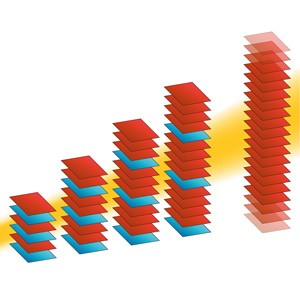Sep. 11, 2015 Research Highlight Physics / Astronomy
Materials enter a new phase
Building materials one atomic layer at a time aids the search for exotic phases of matter
 Figure 1: Changing the number of atomic layers of strontium iridate (red) sandwiched between single layers of strontium titanate (blue) in a superlattice offers a means of controlling the phase of the material. Reprinted with permission from Ref. 1. Copyright 2015 by the American Physical Society.
Figure 1: Changing the number of atomic layers of strontium iridate (red) sandwiched between single layers of strontium titanate (blue) in a superlattice offers a means of controlling the phase of the material. Reprinted with permission from Ref. 1. Copyright 2015 by the American Physical Society.
A new technique for identifying exotic states of matter in crystalline materials has been demonstrated by RIKEN researchers.
The electrons in some crystalline materials work together to create a host of unusual states, or phases. This collective behavior in these so-called correlated electron materials occurs because the electrons interact with each other via an intrinsic property known as spin, which is related to the rotation of the electrons about their axes. Although correlated electron materials have attracted much interest in the past decade, it has proved difficult to identify the exact mechanisms that give rise to specific phases and to determine what drives a material to switch from one phase to another.
Now, Jobu Matsuno from the RIKEN Advanced Science Institute and his colleagues have investigated these mechanisms in a class of materials called iridates1. These materials are interesting because their behavior is predominantly governed by two effects that are roughly equal in magnitude: the repulsive Coulomb force between electrons arising from their electric charge and the spin–orbit interaction, which arises because the spin of an electron interacts with its orbital motion. Theoretical analysis indicates that competition or cooperation between these two effects gives rise to a number of exotic phases in iridates.
To explore the influence of the spin–orbit interaction on the formation of these phases, Matsuno and his team created a series of iridate-based samples and measured their resistivity and magnetism. Each sample had a repeating structure consisting of one, two, three or four atomic layers of strontium iridate and a single layer of strontium titanate; the researchers also measured a sample without strontium titanate (Fig. 1).
“This superlattice technique allows us to control these iridates,” says Matsuno, “and we can thus realize exotic phenomena.”
The scientists found that the magnetic ordering temperature and the resistivity decreased with increasing number of strontium iridate layers. They also discovered that, in the sample containing three atomic layers of strontium iridate, a transition from a semimetal phase to an insulating state was closely linked to the appearance of magnetism.
These results indicate the potential for finding unusual states of matter using the superlattice approach. The team hopes to use the method to identify a phase known as a topological insulator — a recently discovered class of materials that usually have a large spin–orbit interaction. “Theorists say that some iridates might host an even more exotic state called a topological Mott insulator,” Matsuno notes.
References
- 1. Matsuno, J., Ihara, K., Yamamura, S., Wadati, H., Ishii, K., Shankar, V. V., Kee, H.-Y. & Takagi, H. Engineering a spin-orbital magnetic insulator by tailoring superlattices. Physical Review Letters 114, 247209 (2015). doi: 10.1103/PhysRevLett.114.247209
